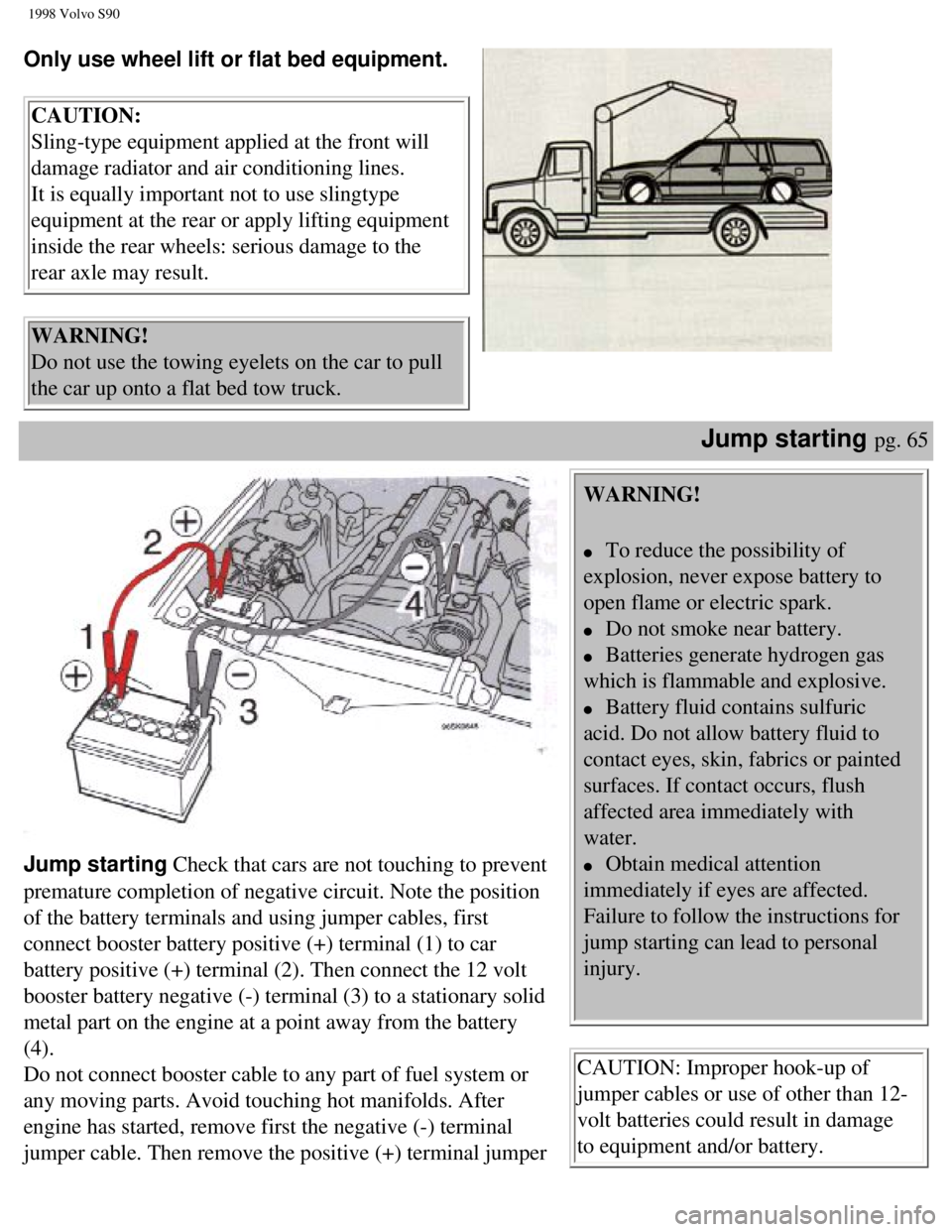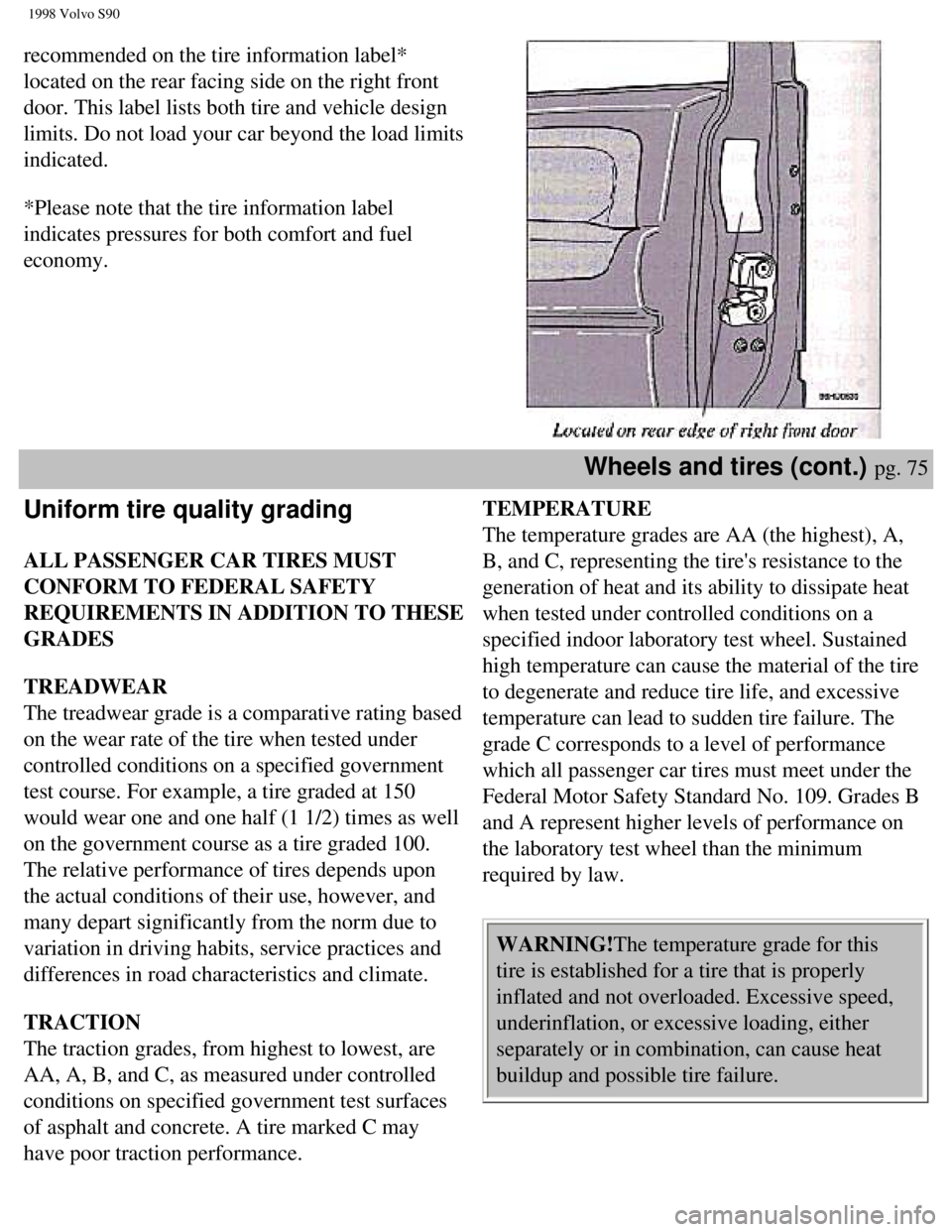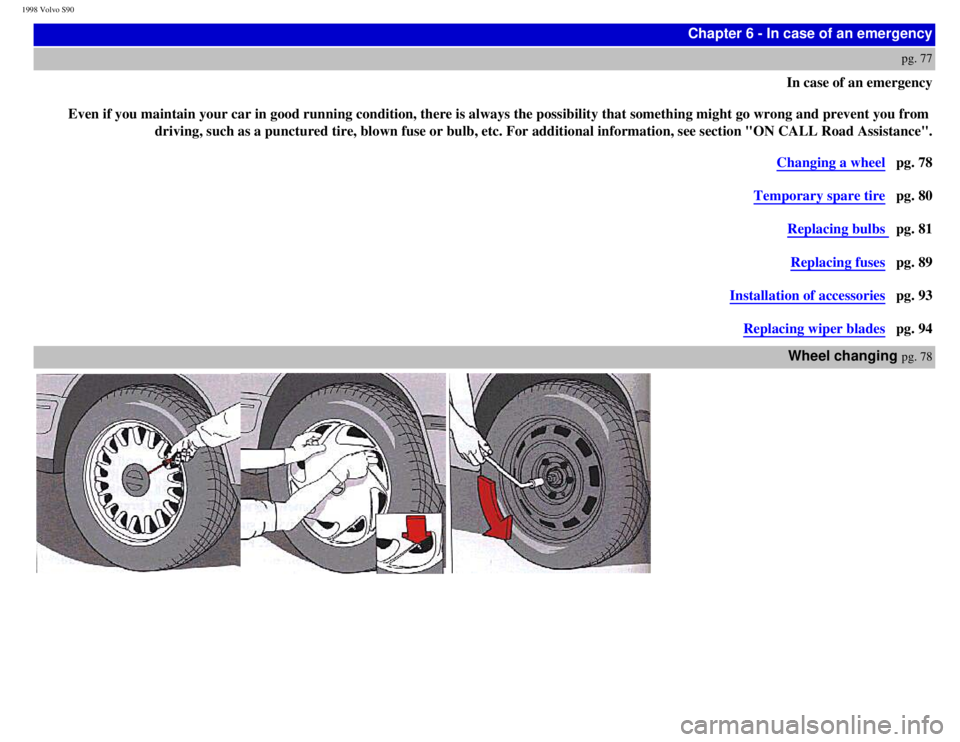1998 VOLVO V90 wheel
[x] Cancel search: wheelPage 74 of 175

1998 Volvo S90
Only use wheel lift or flat bed equipment.
CAUTION:
Sling-type equipment applied at the front will
damage radiator and air conditioning lines.
It is equally important not to use slingtype
equipment at the rear or apply lifting equipment
inside the rear wheels: serious damage to the
rear axle may result.
WARNING!
Do not use the towing eyelets on the car to pull
the car up onto a flat bed tow truck.
Jump starting pg. 65
Jump starting Check that cars are not touching to prevent
premature completion of negative circuit. Note the position
of the battery terminals and using jumper cables, first
connect booster battery positive (+) terminal (1) to car
battery positive (+) terminal (2). Then connect the 12 volt
booster battery negative (-) terminal (3) to a stationary solid
metal part on the engine at a point away from the battery
(4).
Do not connect booster cable to any part of fuel system or
any moving parts. Avoid touching hot manifolds. After
engine has started, remove first the negative (-) terminal
jumper cable. Then remove the positive (+) terminal jumper
WARNING!
l To reduce the possibility of
explosion, never expose battery to
open flame or electric spark.
l Do not smoke near battery.
l Batteries generate hydrogen gas
which is flammable and explosive.
l Battery fluid contains sulfuric
acid. Do not allow battery fluid to
contact eyes, skin, fabrics or painted
surfaces. If contact occurs, flush
affected area immediately with
water.
l Obtain medical attention
immediately if eyes are affected.
Failure to follow the instructions for
jump starting can lead to personal
injury.
CAUTION: Improper hook-up of
jumper cables or use of other than 12-
volt batteries could result in damage
to equipment and/or battery.
file:///K|/ownersdocs/1998/1998_SV90/98S90_063.htm (2 of 4)12/30/2006 \
1:52:43 PM
Page 79 of 175

1998 Volvo S90
Observe legal requirements of
the state in which the vehicles
are registered.
WARNING! Bumper-
attached trailer hitches must
not be used on Volvos, nor
should safety chains be
attached to the bumper.
Trailer hitches attaching to
the vehicle rear axle must
not be used. kgs) a top speed of 50 mph (80
km/h) should never be
exceeded.
l Increase tire pressure to
recommended full-load
pressure. See section "Wheels
and tires".
l Engine and transmission are
subject to increased loads.
Therefore, engine coolant
temperature should be closely
watched when driving in hot
climates or hilly terrain. Use
lower gear and turn off air
conditioner if temperature gauge
pointer enters the red range.
towing a trailer to ensure that the
max. permissible axle load or
gross vehicle weight are not
exceeded.
NOTE: Refer to section
"Automatic transmission" for
additional trailer hauling tips.
Winter driving pg. 69
Cold weather precautions
l If you wish to check your car before the
approach of cold weather, the following advice is
worth noting:
Make sure that the engine coolant contains at least
50 percent antifreeze: that is, 5.3 qts. (5 liters)
Volvo Genuine Coolant/Antifreeze. This gives
protection against freezing down to -31°F (-35°
C). See section "Coolant".
The use of "recycled" antifreeze is not approved
by Volvo. Different types of antifreeze may not be
mixed.
l Try to keep the fuel tank well filled - this
prevents the formation of condensation in the
tank.
In addition in extremely cold weather conditions it
is worthwhile to add fuel line de-icer before
refueling.
l The viscosity of the engine oil is important. Oil
with low viscosity (thinner oil) improves cold-
weather starting as well as decreasing fuel
consumption while the engine is warming up. For
winter use, 5W-30 oil, particularly the synthetic
type, is recommended.
Be sure to use good quality oil but do not use this
l The Volvo Washer Solvent should be diluted as
follows:
Down to 14°F (-10°C): 1 part anti-freeze and 4
parts water
Down to 5°F (-15°C): 1 part anti-freeze and 3
parts water
Down to 0°F (-18°C): 1 part anti-freeze and 2
parts water
Down to -18°F (-28°): 1 part anti-freeze and 1
part water
l Use lock spray or grease in the locks.
NOTE: Avoid the use of de-icing spray as they
can cause damage to the locks.
Automatic differential lock (certain
models)
The differential automatically locks at speed
between 3 - 25 mph (5 - 40 km/h) if either of the
drive wheels begins to lose traction. The
differential lock improves power distribution to
the drive wheels in slippery conditions, shifting
power to the wheel with best traction. It also
file:///K|/ownersdocs/1998/1998_SV90/98S90_067.htm (3 of 5)12/30/2006 \
1:52:43 PM
Page 80 of 175

1998 Volvo S90
cold-weather oil for hard driving or in warm
weather. See section "Engine oil" for more
information.
l The load placed on the battery is greater during
the winter since the heater, windshield wipers,
lighting etc. are used more often. Moreover, the
capacity of the battery decreases as the
temperature drops. In very cold weather, a poorly
charged battery can freeze and be damaged. It is
therefore advisable to check the state of charge
more frequently and spray an anti-rust oil on the
battery posts.
l Volvo recommends the use of snow tires on all
four wheels for winter driving - see section
"Wheels and tires".
l To prevent the washer reservoir from freezing,
add washer solvents containing antifreeze. This is
important since dirt is often splashed on the
windshield during winter driving, thus requiring
frequent use of the washers and wipers.
functions when the transmission is in reverse.
Also see "Winter/Wet" mode on page 59.
Winter/Wet mode
Enhanced Vehicle Traction
This mode may be selected for starting/moving
off on slippery roads or to lower downshift speeds
if the transmission is in "L".
Mode W
*In position D, the gearbox starts in third gear and
changes up to fourth gear.
*In position 3, second gear is locked and there is
no change up to third gear. In position L, first gear
is locked.
*These positions always offer the kick-down
feature.
Long distance trip pg. 70
Before a long distance trip
It is always worthwhile to have your car checked at a Volvo retailer
before driving long distances. Your retailer will also be able to supply\
you with bulbs, fuses, spark plugs and wiper blades for your use in the \
event that problems occur.
If you prefer to check the car yourself, please note the following:
l Check that the engine runs smoothly and that fuel consumption is
normal.
l Check engine oil, coolant levels, and for possible fuel leakage.
l Check transmission oil level and rear axle for leakage.
l Check condition of drive belts.
l Check state of charge of battery.
l Examine tires carefully (the spare tire as well), and replace those
that are worn. Check tire pressures.
l The brakes, front wheel alignment, and steering gear should be
checked by your Volvo retailer only.
l Check all lights, including high beams.
file:///K|/ownersdocs/1998/1998_SV90/98S90_067.htm (4 of 5)12/30/2006 \
1:52:43 PM
Page 82 of 175

1998 Volvo S90
Chapter 5 - Wheels and tires
pg. 71
Wheels and tires
The handling and riding comfort of the vehicle is dependent on the infla\
tion
pressure and the type of tires fitted. Read the following pages carefull\
y.
General information, Wear indicator, Tire economy, Flat spots pg. 72
Snow chains, Winter tires pg. 73
Inflation pressure pg. 74
Uniform tire quality grading pg. 75
Wheels and tires
pg. 72
General information
Your vehicle is equipped with tires according
to the tire information label located on the rear
facing side of the right front door.
The following is an example of a tire designation
code:
195 = tire width in mm.
60 = tire profile. This is the relationship (in
percent) between the section height and the width
of the tire.
R= radial tires.
15 = diameter in inches on all four wheels.
The tires have good road holding characteristics
and offer good handling on dry and wet surfaces.
Your Volvo may be equipped with "all-season"
tires, which provide a somewhat higher degree
of winter roadholding on slippery surfaces
than tires without the "all-season" rating.
However, for optimum road holding on icy or
snow covered roads - we recommend suitable
winter tires. When replacing worn tires, it is recommended
that the tire be identical in type (radial) and size as
the one being replaced. Using a tire of the same
make (manufacturer) will prevent alteration of the
driving characteristics of the vehicle.
To improve tire economy:
l Maintain correct tire pressure.
l Drive smoothly: avoid fast starts, hard braking
and tire screeching.
l Tire wear increases with speed.
l Correct front wheel alignment is very
important. Unbalanced wheels impair tire
economy and driving comfort.
l If the wheels are rotated, they should be kept on
the same side of the car so that they revolve in the
same direction as prior to rotation.
l Hitting curbs or potholes can damage the tires
and/or wheels permanently.
Flat spots
file:///K|/ownersdocs/1998/1998_SV90/98S90_071.htm (1 of 5)12/30/2006 \
1:52:44 PM
Page 83 of 175

1998 Volvo S90
When replacing tires, be sure that the new tires
are the same size designation, type (radial) and
preferably from the same manufacturer, on all
four wheels. Otherwise there is a risk of altering
the car's road-holding and handling
characteristics.
NOTE:When storing wheel/tire assemblies (e.g.
winter tires and wheels), either stand the
assemblies upright or suspend them off the
ground. Laying wheel/tire assemblies on their
sides for prolonged periods can cause wheel and/
or tire damage.
Wear indicator
The tires have a so-called "wear indicator" in the
form of a number of narrow strips running across
or parallel to the tread. When approx. 1/16" (1.6
mm) is left on the tread, these strips show up and
indicate that the tire should be replaced.
Tires with less than 1/16" (1.6 mm) tread have a
very poor grip in rain or snow.
All tires become warm during use. After cooling,
when the vehicle is parked, the tires have a
tendency to distort slightly, forming flat spots.
These flat spots can cause vibrations similar to the
vibrations caused by imbalanced wheels.
They do, however, disappear when the tire warms
up. The degree to which the flat spots form
depends on the type of cord used in the tire.
Remember that, in cold weather, it takes longer
for the tire to warm up and consequently longer
for the flat spot to disappear.
Wheels and tires (cont.) pg. 73
Snow chains
Snow tire chains can be used on your Volvo with
the following restrictions:
l Snow chains should be installed on rear wheels
only. Use only Volvo approved snow chains.
l Snow chains can only be used on tires which
are not wider than 195 mm.
l Sufficient clearances between chains and
brakes, suspension and body components must be
maintained.
l Some strap-on type chains will interfere with
brake components and therefore CANNOT be
used.
Consult your Volvo retailer for additional snow
Snow tires, studded tires*
Tires for winter use:
Owners who live in or regularly commute
through areas with sustained periods of snow
or icy driving conditions are strongly advised
to fit suitable winter tires to help retain the
highest degree of traction.
It is important to install winter tires on all four
wheels to help retain traction during cornering,
braking and accelerating. Failure to do so could
reduce traction to an unsafe level or adversely
affect handling. Do not mix tires of different
design as this could also negatively affect overall
tire road grip.
file:///K|/ownersdocs/1998/1998_SV90/98S90_071.htm (2 of 5)12/30/2006 \
1:52:44 PM
Page 84 of 175

1998 Volvo S90
chain information.
CAUTION:
l Check local regulations regarding the use of
snow chains before installing.
l Always follow the chains manufacturer's
installation instructions carefully. Install
chains as tightly as possible and re-tighten
periodically.
l Never exceed the chain manufacture's
specified maximum speed limit. (Under no
circumstances should that limit be higher than
30 mph (50 km/h).
l Avoid bumps, holes or sharp turns when
driving with snow chains.
l The handling of the vehicle can be adversely
affected when driving with chains. Avoid fast
or sharp turns as well as locked wheel braking.
Winter tires wear more quickly on dry roads in
warm weather. They should be removed when the
winter driving season has ended.
Studded tires should be run-in 300-600 miles
(500-1000 km) during which the car should be
driven as smoothly as possible to give the studs
the opportunity to seat properly in the tires. The
car tires should have the same rotational direction
throughout their entire lifetime. In other words, if
you wish to rotate the wheels, make sure that the
same wheels are always on the same side of the
car.
NOTE: Please consult state or local regulations
restricting the use of studded winter tires before
installing such tires.
WARNING! Special wheel rims for air dams
Only special wheel rims, tested and approved
by Volvo, are suitable for use with the air dam
installed on the S90/V90.
*Where permitted.
Wheels and tires (cont.) pg. 74
Checking and correcting tire
pressure
Check the tire pressure when refueling.
The tire pressure should be corrected only when
the tires are cold. With warm tires, correct only
when the pressure is too low. The tire temperature
rises after driving just a few miles.
Vehicle Loading
The tires on your Volvo will perform to
specifications at all normal loads when inflated as
file:///K|/ownersdocs/1998/1998_SV90/98S90_071.htm (3 of 5)12/30/2006 \
1:52:44 PM
Page 85 of 175

1998 Volvo S90
recommended on the tire information label*
located on the rear facing side on the right front
door. This label lists both tire and vehicle design
limits. Do not load your car beyond the load limits
indicated.
*Please note that the tire information label
indicates pressures for both comfort and fuel
economy.
Wheels and tires (cont.) pg. 75
Uniform tire quality grading
ALL PASSENGER CAR TIRES MUST
CONFORM TO FEDERAL SAFETY
REQUIREMENTS IN ADDITION TO THESE
GRADES
TREADWEAR
The treadwear grade is a comparative rating based
on the wear rate of the tire when tested under
controlled conditions on a specified government
test course. For example, a tire graded at 150
would wear one and one half (1 1/2) times as well
on the government course as a tire graded 100.
The relative performance of tires depends upon
the actual conditions of their use, however, and
many depart significantly from the norm due to
variation in driving habits, service practices and
differences in road characteristics and climate.
TRACTION
The traction grades, from highest to lowest, are
AA, A, B, and C, as measured under controlled
conditions on specified government test surfaces
of asphalt and concrete. A tire marked C may
have poor traction performance. TEMPERATURE
The temperature grades are AA (the highest), A,
B, and C, representing the tire's resistance to the
generation of heat and its ability to dissipate heat
when tested under controlled conditions on a
specified indoor laboratory test wheel. Sustained
high temperature can cause the material of the tire
to degenerate and reduce tire life, and excessive
temperature can lead to sudden tire failure. The
grade C corresponds to a level of performance
which all passenger car tires must meet under the
Federal Motor Safety Standard No. 109. Grades B
and A represent higher levels of performance on
the laboratory test wheel than the minimum
required by law.
WARNING!The temperature grade for this
tire is established for a tire that is properly
inflated and not overloaded. Excessive speed,
underinflation, or excessive loading, either
separately or in combination, can cause heat
buildup and possible tire failure.
file:///K|/ownersdocs/1998/1998_SV90/98S90_071.htm (4 of 5)12/30/2006 \
1:52:44 PM
Page 87 of 175

1998 Volvo S90
Chapter 6 - In case of an emergency
pg. 77
In case of an emergency
Even if you maintain your car in good running condition, there is always\
the possibility that something might go wrong and prevent you from
driving, such as a punctured tire, blown fuse or bulb, etc. For addition\
al information, see section "ON CALL Road Assistance".
Changing a wheel pg. 78
Temporary spare tire pg. 80
Replacing bulbs pg. 81
Replacing fuses pg. 89
Installation of accessories pg. 93
Replacing wiper blades pg. 94
Wheel changing
pg. 78
file:///K|/ownersdocs/1998/1998_SV90/98S90_077.htm (1 of 4)12/30/2006 \
1:52:45 PM